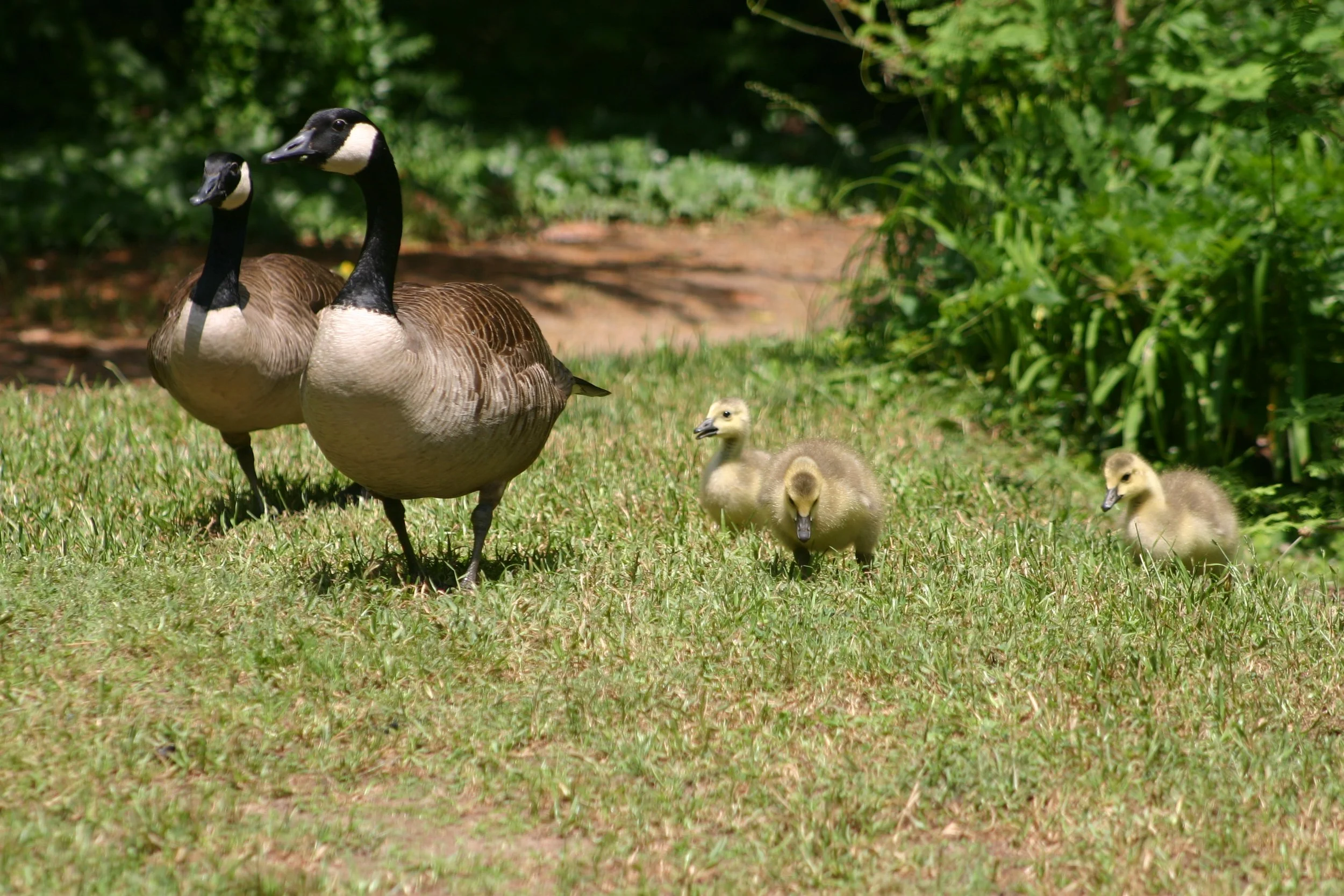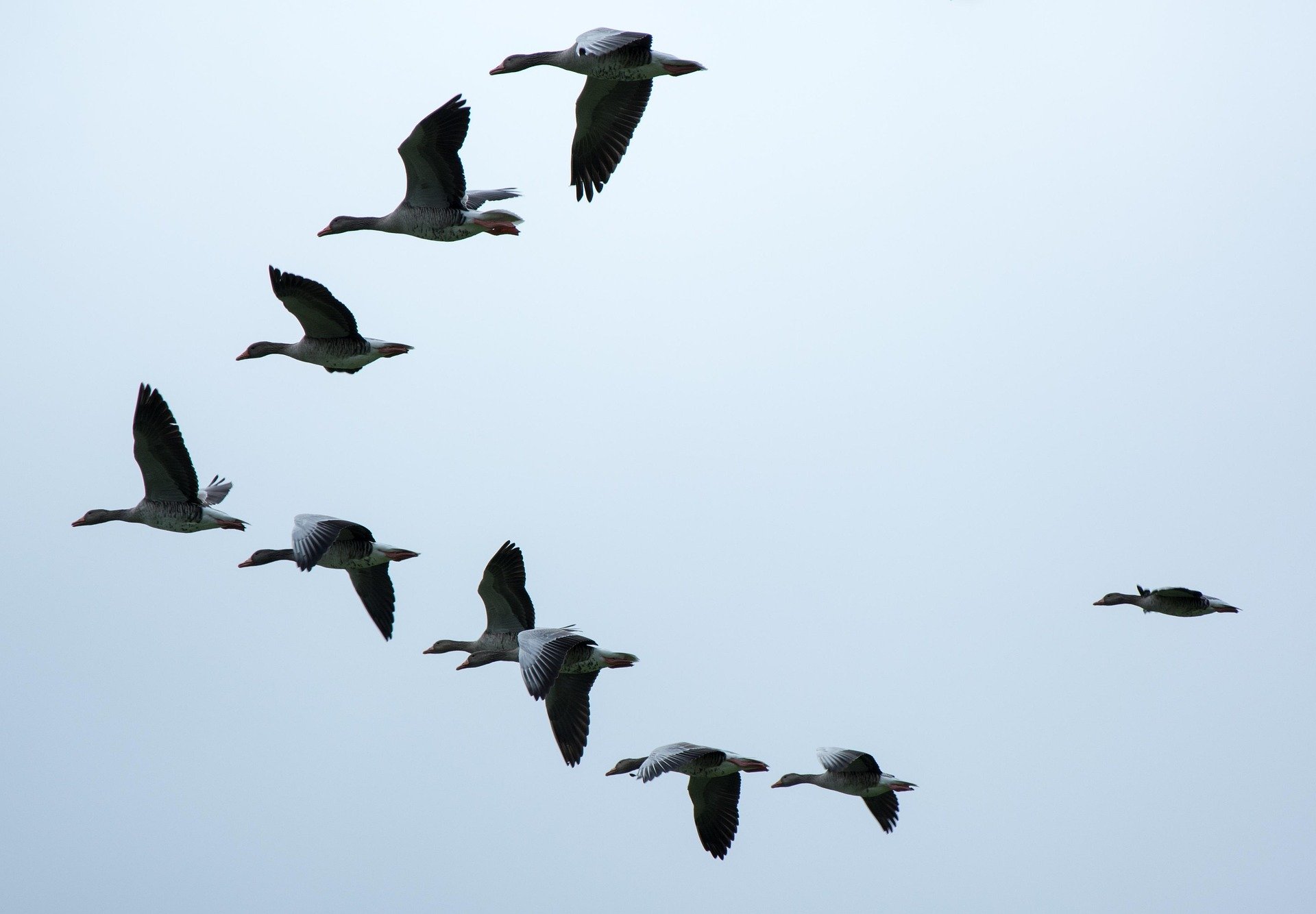Three times in the past month, I have slowed my car to a dead stop to allow a family of geese to cross the roadway. I was especially impatient last week; the goose parade was making me late for an appointment. Each time, one large bird stopped directly in front of my car and gave me the stink-eye while his companions meandered across, in no hurry despite my lurking, revving, combustion engine device that could have squashed them all into paté in a heartbeat. Or so I thought. The big old gander seemed to say, “Oh yeah? Just try it.” I didn’t try it.
To excuse my tardiness, I said to the office receptionist, “Well, this group of Canadian geese was…”
“Canada geese,” she interrupted.
“What?”
“They’re not Canadian geese. They’re Canada geese.”
Properly chastised, I took my seat in the waiting room to use my phone (directly under the sign that said No Cellphones – I’m a rebel when it doesn’t count) to check it out. And you know what? She was 100% correct.
Canada geese are imposing birds. Typical males weigh from five to fourteen pounds. Females are a little lighter. There are seven subspecies, ranging in size from small to extra large. The biggest is Branta canadensis maxima, appropriately called the giant Canada Goose. All species have beautiful markings: black heads with a white chin strap and bib.
Geese are two years old before they take a mate, and they remain dedicated to that mate for life. There is no crossover between subspecies, as the males seek females of similar size to themselves. Mated females lay an average clutch of five eggs. These nests are depressions in the ground, lined by plant leaves and down pulled from their own bodies. The nests are located near water, but goose parents instinctively choose an elevated site to guard against flooding. Both males and females incubate the eggs, but females spend more time egg-sitting than the males. Eggs hatch in about thirty days. The babies, known as goslings, are able to swim within an hour of their birth. Parents are fiercely protective of their young. Curious observers that get too close will be met with hissing, followed by biting and wing-slapping. Their bites pack some power, and they seem to target the tender spot behind one’s knees for their assaults.
Canada geese are native to North America. Decades ago, they spent most of the year in the northernmost parts of the US and Canada. They would migrate southward for the winter, forming those familiar V shapes in the sky. The V shape allows one bird to set the pace which others draft it, meaning the followers use less energy. When the leader is exhausted, he drops back to one of the legs of the V and a new leader takes over. It’s like a Tour de France race team. Over time, migration has been reduced and ever-increasing numbers of Canada geese remain in the lower states all year long, even as far south as Florida. Is this due to climate change? Land development? Good southern eats? Who knows.
Canada geese are primarily herbivores, dining on a variety of plant materials. They will occasionally grab an insect. Their food of choice appears to be grass. Specifically, that expensive sod you have around your home. The same grass that you fertilize, water, mow, and treat with loving care. This brings me to the reason that I am talking about geese in a blog that normally focuses on horticulture and plant needs.
As geese are spending more and more months around the waterways of the southeast, I am receiving more inquiries on how can one keep them out of yards, off docks, and force them into the water, where homeowners insist they belong. I understand. Geese eat a lot and they deposit a lot of slick, smelly fecal matter. They leave behind feathers that sully the perfect golf-course laws we covet. While this is maddening, it is important to realize that Canada geese are federally protected. The SC Department of Natural Resources website says, “Canada geese are protected by the Migratory Bird Treaty Act of 1918 and various other state and federal laws. In accordance with these laws, it is unlawful to hunt, kill, sell, purchase or possess migratory birds…”
So, how does a homeowner discourage goose visits? There are several steps a homeowner can legally take. If your home property borders a waterway, leave a five-foot strip of grass unmowed next to the waterline. Add a few shrubs for additional inhospitality. Geese don’t like to struggle through a rough to get to your Zenon Zoysia or DuraBlend Fescue. Fencing is always an option, but most homeowners don’t want to replace water views with fence features. HOA covenants may prohibit fencing as a visual detriment to the community. Around decks and docks, string a few strands of monofilament fishing line at a height around goose-head level. The clear strands are hardly visible from a short distance, and geese find them unpleasant and disorienting. You can use loud motion-activated scare devices (music, static, whatever) but neighbors might be unhappy at such a disturbance. Some homeowners have found that a plastic coyote or swan placed on a dock, balloons or shiny CDs hung from a short pole, motion-activated sprinklers, or even umbrellas make geese think predators are lurking and they will seek friendlier territory. It is important to take any of these steps to discourage before mating and nesting season. Once geese have made your home into their home, you are sunk. Just tolerate them as best you can and get an earlier start next year. They are beautiful birds who deserve their place in the natural world.
This mated pair took their young family for a stroll at Hatcher Garden and Woodland Preserve, in Spartanburg, SC. The nearby paved path was closed a few weeks while the eggs were under incubation and when the goslings emerged. Don’t the parents look proud?


